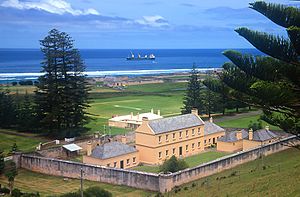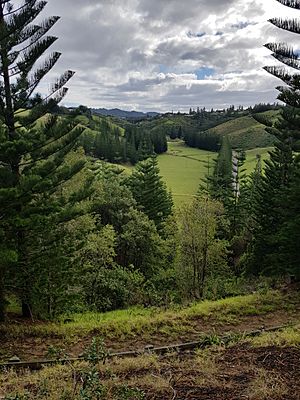Kingston and Arthur's Vale Historic Area facts for kids
Quick facts for kids Kingston and Arthurs ValeHistoric Area |
|
|---|---|

Military Barracks and Officer Quarters (1829–34), Quality Row Military Precinct, within Kingston and Arthurs Vale Historic Area.
|
|
| Type | Historic Area |
| Location | Quality Row, Kingston, southern side of Norfolk Island |
| Area | 255 ha (630 acres) |
| Status | Australian National Heritage List World Heritage list |
| Website | http://kavha.gov.au/ |
| Type: | Cultural |
| Criteria: | iv, vi |
| Designated: | 2010 (34th session) |
| Part of: | Australian Convict Sites |
| Reference #: | 1306 |
| Region: | Asia-Pacific |
The Kingston and Arthurs Vale Historic Area (KAVHA) is a very old settlement on the southern coast of Norfolk Island. It has many buildings from the time when the British Empire sent convicts (prisoners) to Australia, between 1788 and 1855.
KAVHA is so important that it is on both the Australian National Heritage List and UNESCO's World Heritage list. It is seen as one of the best examples of how convicts were transported and how European countries expanded using their labor.
This historic area is special because it shows evidence of early Polynesian people living there. It is also the place where the descendants of the Bounty mutineers, who had lived on Pitcairn Island, moved in 1856. KAVHA is one of 11 places that make up the Australian Convict Sites World Heritage list, added on July 31, 2010. It was added to the National Heritage List on August 1, 2007.
KAVHA was known as one of the toughest and most difficult places for convicts in Australia. However, it was also a place where some new ideas for improving prison life were tried. KAVHA is located about 1,600 kilometers east-north-east of Sydney. It is on a coastal plain surrounded by hills. The area includes many old convict buildings, some of which were changed later by the Pitcairn Islanders. It also has ruins, old structures, and archaeological sites. People have always admired KAVHA's beautiful setting, its historical connections, and how it has remained largely unchanged over time.
Contents
Early People of Norfolk Island
Europeans were not the first people to live on Norfolk Island. Stone tools have been found at Emily and Slaughter bays within KAVHA. Digs by archaeologists have shown signs of changes to the land in the Emily Bay area. They found old tools and building remains that seem to be a simple marae. A marae is a religious structure common in East Polynesian culture. Scientists have used radiocarbon dating to show that Polynesian people lived here between AD 1200 and AD 1600.
The First European Settlement
Captain James Cook discovered Norfolk Island in 1774. Six weeks after the First Fleet arrived in Sydney, Europeans settled on Norfolk Island on March 6, 1788. Cook had reported that the island had rich soil, tall pine trees for ship masts, and native flax for making canvas. Governor Philip was told to settle the island quickly to get these important naval supplies.
Lieutenant Philip Gidley King and a group of convicts and staff arrived on the ship Supply. They started a settlement called Kingston. They planted crops in the nearby valley, Arthurs Vale. Unlike Sydney, the crops in Kingston grew very well. To help with food shortages in the new colony of New South Wales, Governor Philip moved about one-third of Sydney's population to Kingston.
A lot of land was cleared for farming. Both convicts and free settlers worked on small farms. The land behind Kingston was cleared so that guards could watch for escaping convicts. The population of this first settlement reached its highest point in May 1792, with 1,156 people. By 1804, free settlers made up most of the population. When the settlement was abandoned in 1814, its buildings were destroyed.
The Second Settlement
In 1824, the British government decided to re-occupy Norfolk Island. This was after a report suggested that sending convicts to far-off places was not scary enough. The island was to be a "great hulk or penitentiary" for "secondary punishment." This meant it was for convicts who had already been sent to Australia but then committed more crimes. The goal was to make transportation seem more frightening and stop crime in Britain and the colonies.
Norfolk Island was re-settled on June 6, 1825. Captain Turton arrived with soldiers, convicts, women, and children. The settlement was again around Kingston. Some of the first settlement's buildings were rebuilt, and old farming areas were used again. However, this new settlement was very different. The second settlement on Norfolk Island was meant to be the worst possible place for convicts. It became a symbol of the harshest parts of the transportation system.
Life for Convicts
Convicts worked from sunrise to sunset. They used hoes and spades for farming; no plows or working animals were used. Their living spaces were crowded and dirty. This, along with poor food (only one meal every 48 hours), led to bad health and many deaths. The harsh treatment was meant to break their spirit. Floggings (whippings) were common, even for small mistakes, and sentences could be made longer.
The most difficult convicts from New South Wales and Van Diemen's Land (now Tasmania) were sent to Norfolk Island. These men had become so hardened by the system that more punishment only made them more rebellious. Even the threat of death did not stop them. The men in charge of Norfolk Island and its convicts were part of a very brutal system themselves.
Some of the commandants, like Captain James Morisset, Major Joseph Childs, and John Price, were especially cruel. Mutinies (rebellions) and uprisings happened often. These usually led to more floggings and hangings. During Morisset's time as commandant (1829–34), he used the whip a lot. This is when Norfolk Island became known as "hell on earth." By 1833, the island's terrible reputation was well known in Britain.
A New Way of Thinking About Prisons
Only one commandant, Alexander Maconochie, brought a more humane approach to the second settlement. He was in charge for four of its 30 years. He started the Merits System of Penal Discipline. This system allowed prisoners to earn their freedom if they worked hard and behaved well. His ideas did not last for several reasons, including that his bosses did not approve of his reforms. Under Maconochie, conditions for prisoners got better. However, they quickly became worse again under the next commandant, Major Joseph Childs.
The Final Years
In the later years of the second settlement, prisoners began arriving directly from Britain. They served the first part of their punishment under a new system started in 1843. The harshness of the place continued. In 1847, Catholic Bishop Robert Wilson wrote a report to the British Parliament. He described the terrible conditions on Norfolk Island. His report helped bring an end to the island being used as a penal settlement. It was slowly closed between 1847 and 1855. Some convicts were released, while others were sent to Port Arthur to finish their sentences. On December 29, 1853, an official order ended all previous orders making Norfolk Island a penal settlement. A small group stayed on the island to look after the farms and animals. They waited to hand over the island to the new settlers from Pitcairn Island. These settlers started the third phase of the island's history.
The Third Settlement
The descendants of the Bounty mutineers on Pitcairn Island had grown too numerous for their small island home. So, the British government decided to move them to Norfolk Island. The entire Pitcairn community arrived at Kingston Pier on June 8, 1856.
Their descendants make up almost a third of Norfolk Island's population today. They still speak the Pitcairn language. For them, KAVHA is very important. They have used it continuously since their arrival as a place to live, work, worship, and relax. KAVHA is special because a unique Polynesian/European community has lived there and kept their cultural traditions for over 150 years.
Important Buildings
Some of KAVHA's main buildings include:
- The Government House from 1829. It is one of the oldest and most complete government house buildings in Australia. It has great views of the settlement.
- The Old Military Barracks and officers' quarters, built between 1829 and 1834. High walls surround them, making them look like a military fortress.
- The New Military Barracks, started in 1836, also has a fortress-like design.
- The Commissariat Store, from 1835, is the best remaining colonial military store in Australia from before 1850.
- The elegant Quality Row houses. These were living quarters for military and civil officers. The military buildings are on higher ground to watch over the convict area, which is closer to the water and lower down.
You can also find the remains of two convict jails at KAVHA. There are also the walls and remains of the prisoners' barracks (1828–48) with the Protestant chapel. These show how ideas about prisons changed over time. The first jail was built like a barracks. The remains of the new prison (1836–40, 1845–57) show a rare radial design, where sections spread out from a central point.
Other old remains include the blacksmith's shop (1846), the lumber yard, a water mill, and the crankmill (1827–38). The crankmill is the only known human-powered crankmill built in Australia before 1850. There is also the salt house (1847), the windmill base (1842–43), and lime kilns. The landing pier (1839–47) and sea wall are two of the earliest large engineering works still remaining in Australia. The Protestant and Catholic clergyman's quarters show the role of religion in trying to reform prisoners.
See also
 In Spanish: Área histórica de Kingston y Arthur's Vale para niños
In Spanish: Área histórica de Kingston y Arthur's Vale para niños
- Norfolk Island Museum


